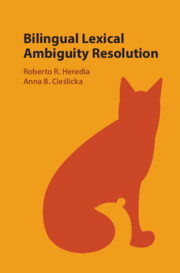Book contents
- Bilingual Lexical Ambiguity Resolution
- Bilingual Lexical Ambiguity Resolution
- Copyright page
- Dedication
- Contents
- Figures
- Tables
- Contributors
- Preface
- Acknowledgments
- Part I Theoretical and Methodological Considerations
- Part II Bilingual Lexical Processing
- 4 Cognate Processing Effects in Bilingual Lexical Access
- 5 Translation Ambiguity
- 6 Lexical Selection and Competition in Bilinguals
- Part III Bilingual Sentence Processing
- Part IV Neuroscience of Bilingual Lexical Access
- Author Index
- Subject Index
- References
4 - Cognate Processing Effects in Bilingual Lexical Access
from Part II - Bilingual Lexical Processing
Published online by Cambridge University Press: 24 December 2019
- Bilingual Lexical Ambiguity Resolution
- Bilingual Lexical Ambiguity Resolution
- Copyright page
- Dedication
- Contents
- Figures
- Tables
- Contributors
- Preface
- Acknowledgments
- Part I Theoretical and Methodological Considerations
- Part II Bilingual Lexical Processing
- 4 Cognate Processing Effects in Bilingual Lexical Access
- 5 Translation Ambiguity
- 6 Lexical Selection and Competition in Bilinguals
- Part III Bilingual Sentence Processing
- Part IV Neuroscience of Bilingual Lexical Access
- Author Index
- Subject Index
- References
Summary
One of the crucial questions in bilingual research is whether all languages known to a bilingual speaker are coactivated during language processing. Psycholinguists have frequently addressed this issue by comparing processing patterns of words shared across languages with the processing of language-specific items. The present chapter offers a brief review of studies investigating the processing of cognates (i.e., words that share form and meaning across languages) and noncognates, followed by a discussion of factors affecting cognate processing in bilingual research. The influence of these factors is discussed with respect to the type of cognates involved in the materials, task demands, and, finally, in terms of participants’ individual differences.
Keywords
- Type
- Chapter
- Information
- Bilingual Lexical Ambiguity Resolution , pp. 71 - 95Publisher: Cambridge University PressPrint publication year: 2020
References
Further Reading
References
- 7
- Cited by



